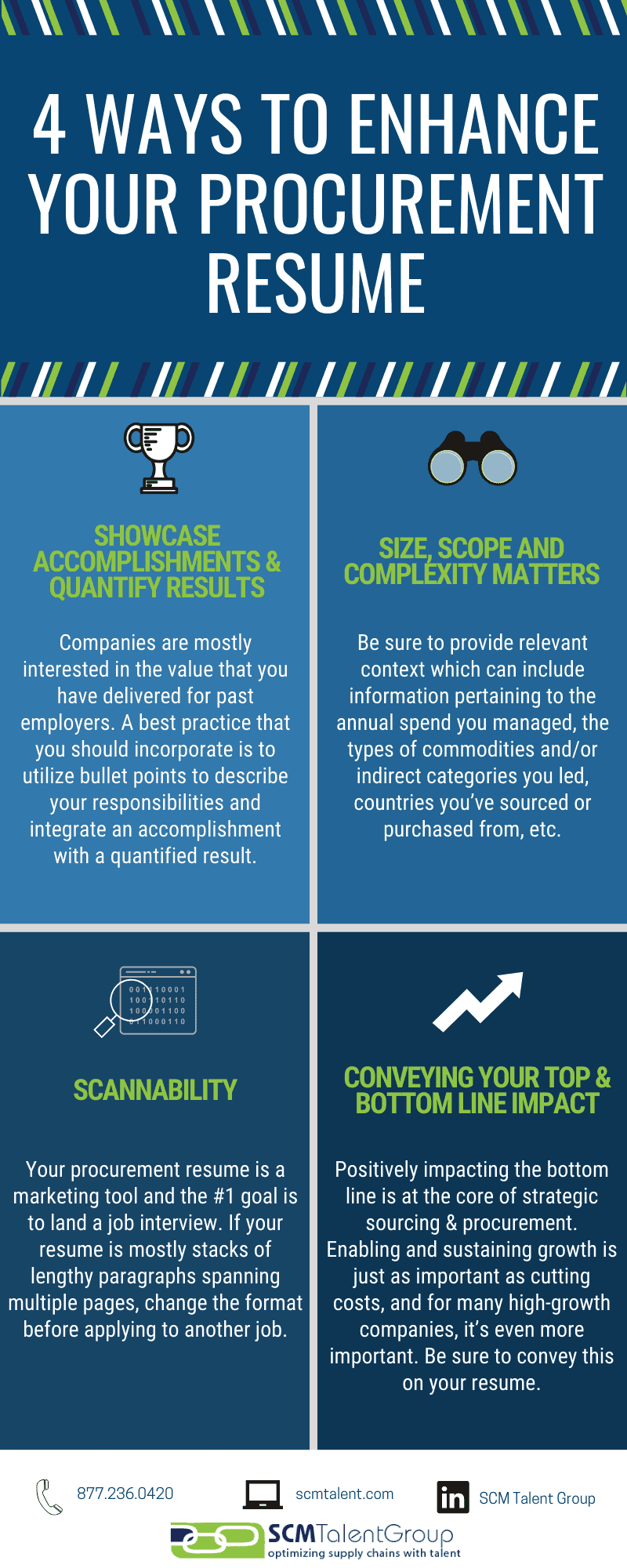
4 Ways to Enhance Your Procurement Resume
Having specialized in procurement and supply chain recruitment for about 2 decades, I’d like to fill you in on a few must-have elements that you’ll want to incorporate into your procurement resume in efforts to optimize its effectiveness. My hopes are that some of these tips will help improve your job application to interview ratio and ultimately lead to the job of your dreams.
1. Showcase Accomplishments within Procurement and Quantify Results
One of the most common resume mistakes that you can make is to only state your roles and responsibilities. You must also list out your accomplishments AND quantify the results.
Why? Companies are mostly interested in the value that you have delivered for past employers, whether it be achieving targeted cost reductions, enabling new product development, mitigating risks to the business, improving supplier performance, and the like.
A best practice that you should incorporate into your procurement resume is to utilize bullet points to describe your responsibilities and integrate an accomplishment with a quantified result.
For example, instead of stating “responsible for managing supplier performance” you could try “leveraged a balanced scorecard and quarterly business reviews with our core supplier base that led to all suppliers achieving 98% or better on-time delivery performance, resulting in $2.5M in annual cost savings.”
2. Size, Scope and Complexity Matters
Every procurement organization is different in size, scope, and complexity. As a Strategic Sourcing & Procurement Recruiter, I’m not just looking for someone that meets the basic and preferred qualifications defined within a job description. We’re also assessing candidates to ensure they align with our client companies as it relates to size, scope, and complexity.
When you omit the right level of context from your procurement resume, assumptions can and will be made by employers and recruiters, which can lead to your resume being passed over. Be sure to include relevant context which can include information pertaining to the annual spend you managed, the types of commodities and/or indirect categories you led, countries you’ve sourced or purchased from, etc.
3. Conveying Your Top & Bottom Line Impact
Positively impacting the bottom line is at the core of strategic sourcing & procurement. We also love to read about the things you’ve done to help improve the top line of an organization. Enabling and sustaining growth is just as important as cutting costs, and for many high-growth companies, it’s even more important.
Be sure to detail what you’ve done to improve both bottom and top-line performance from a sourcing and procurement perspective, and don’t forget to quantify your results.
4. Scannability
A resume study from The Ladders shows that most job seekers believe recruiters spend 4 to 5 minutes on average reviewing a resume. The truth is that recruiters spend about 6 seconds before they make the initial Yes / No / Maybe decision. This means that prioritizing your information in an easy-to-scan layout and emphasizing your most relevant skills, experience and qualifications based on the type of role you’re applying to, is critical in efforts to pass the initial resume scan.
Always remember that your procurement resume is a marketing tool and the #1 goal of your resume is to land a job interview, not to describe in fine detail everything you’ve ever done for every job at every employer you’ve worked for. If your resume is mostly stacks of lengthy paragraphs spanning multiple pages, I strongly suggest changing the format before applying to another job.
Bonus Tips – Here’s my advice for making your procurement resume easier to scan:
- Bold and capitalize all Headings (e.g. Name, Summary, Experience, Education, Certifications, etc.) in a font size of 14 – 16. Use 11 or 12 for everything else.
- Use Helvetica or Arial for font style as these are the two most popular. Avoid Times New Roman as it’s considered outdated.
- Incorporate proper spacing between each section of your resume as this makes it much easier for the human eye to efficiently and quickly scan across and down.
- Bullets are mandatory, never write long paragraphs!
- Each bullet point should contain a brief action-oriented sentence or two that quickly explains a) responsibility, b) accomplishment and c) quantified result (know that it’s perfectly acceptable not to have a quantified results for each bullet point as some things cannot be quantified).
- Strike a good balance between too much detail and not enough detail with the goal of providing just enough information to WOW your audience. Don’t forget to detail size and scope for the areas of the strategic sourcing and procurement that you’ve managed or supported, as covered above in Tip #2.
- Try to refrain from abbreviating and using acronyms unless they’re very common to industry e.g. SCM, TCO, etc.
- Keep your procurement resume to 2 pages or less. Seriously, there is no need to have 3 or more pages for your resume, even if you’re a a Chief Procurement Officer (CPO)!
I hope these procurement resume tips will help you with landing more job interviews. Speaking of, if you would like to be considered for future sourcing & procurement employment opportunities represented by SCM Talent Group, simply submit your procurement resume to our secure database.
